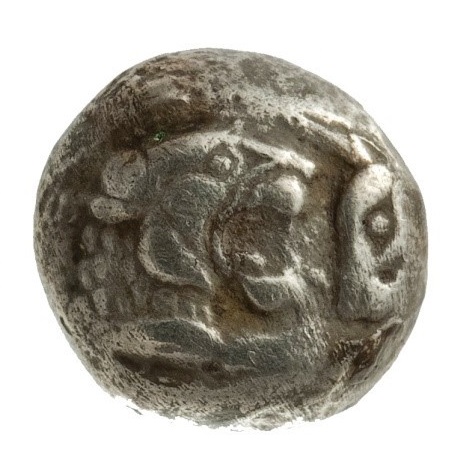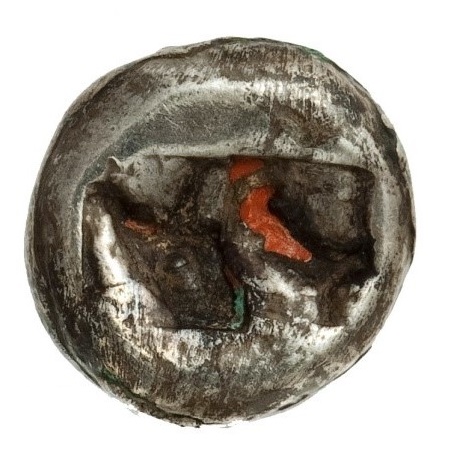Title: Siglos of Kroisos (Croesus) of Lydia - 1968.11
Acquisition number: 1968.11
Author or editor: Douglas Kelly
Culture or period: Lydian (Archaic Greece).
Date: c. 560 - 530 BC.
Material: Metal - Silver
Object type: Coins - Greek
Dimensions: 15mm (w)
Origin region or location: Türkiye
Origin city: Sardis.
Display case or on loan: 5
Keywords: Coin, Greek, Classical, Kroisos, Croesus, Lydia
Sylloge Nummorum Graecorum, Great Britain, Ashmolean (London, The British Academy, 1951-), 760 (Kroisos).
Sylloge Nummorum Graecorum, Copenhagen, The Royal Collection of Coins and Medals, Danish National Museum, repr. edn (West Milford, NJ, 1981-), 456 (Cyrus to Dareios I).
1968.11
Siglos of Kroisos (Croesus) of Lydia
Plated silver 3.93 g.15 mm. c. 560-c. 530 BC.
Obv.: Lion’s head r. towards bull’s head l.
Rev.: Irregular incuse square.
The obverse of the coin is off-centre and only part of the bull’s head appears. This makes it difficult to determine whether the coin was struck in the time of Kroisos (Croesus) (560-546 BC) or later under Persian rule (546-510 BC, Cyrus to Dareios I). The Persian coinage marked a deterioration of style.
Kroisos, king of Lydia on the west coast of Asia Minor, became a byword in the Greek world for wealth (hence the saying, ‘as rich as Croesus’) and was believed to have ruled the first state to issue coins. Lydian coinage had begun early in the sixth century BC with coins made of electrum (a naturally occurring mixture of gold and silver).
Later, apparently in the reign of Kroisos, the Lydian royal mint at Sardis issued gold coins, the stater of c. 8.05 g., and silver coins, the siglos of c. 5.35 g. Twenty silver sigloi were equivalent to one gold stater, giving a ratio of gold to silver of 1: 13.5, which lasted with minor variations down to the time of Alexander the Great.
Electrum coins show the lion’s and bull’s heads back-to-back. The obverse on the silver sigloi, which showsthese two heads facing each other, has been taken to symbolise the separation of the two precious metals.
This coin is plated: that is, a thin outer coating of silver covers a base-metal core. The coin is not necessarily a forgery: plated coins were produced at times by respectable mints, and their circulation shows they were treated as currency, interchangeable with any other coins, not as bullion (pieces of precious metal).
Lydian coinage continued to be issued after the Persian conquest of the kingdom in c. 546 BC until it was replaced in the reign of Dareios I (522-486 BC) in the last quarter of the century by gold darics and silver sigloi, Persian coins showing an archer, believed to represent the Great King of Persia.
Lydian coinage, with its fixed weights of precious metal guaranteed by the images attesting the authority of the power that issued it, provided the model and stimulus for Greek states to adopt this new artefact, with Aigina (cf. 1973.26) leading the way. Gold and electrum issues by Greek poleis were rare until Macedonian times. High-value Greek coinage was predominantly silver, on the pattern of the siglos, with smaller denominations, created by subdividing the basic unit, soon to follow.
The spread of coinage throughout the Greek world from c. 550 BC onwards is a remarkably swift adoption of a new institution from another culture. In contrast, the Persian darics and sigloi circulated in only the western fringes of the Persian empire, mainly in areas with close contact with Greeks.
Sylloge Nummorum Graecorum, Great Britain, Ashmolean (London, The British Academy, 1951-), 760 (Kroisos).
Sylloge Nummorum Graecorum, Copenhagen, The Royal Collection of Coins and Medals, Danish National Museum, repr. edn (West Milford, NJ, 1981-), 456 (Cyrus to Dareios I).

